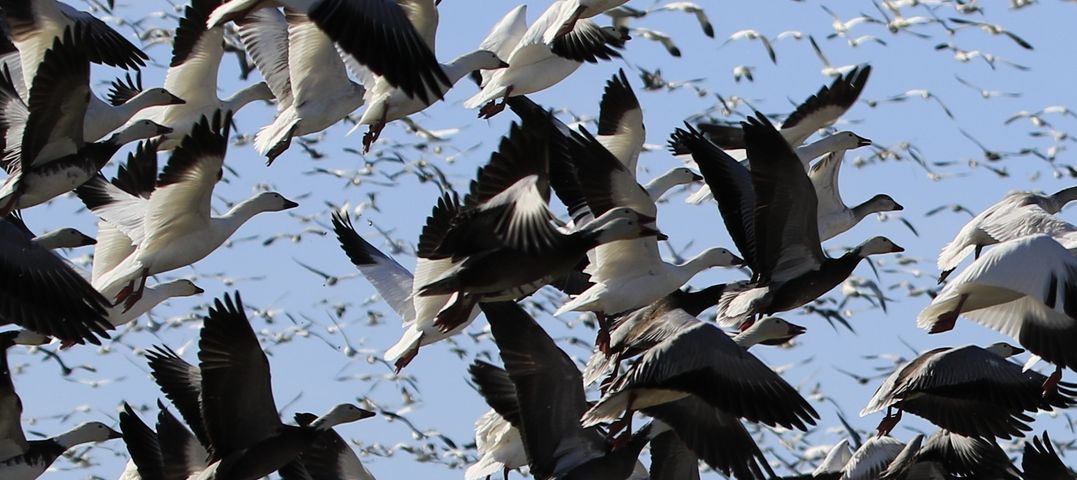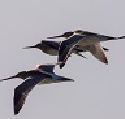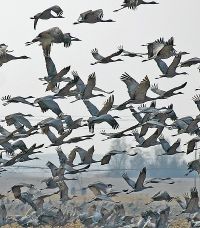
In spring and fall, you may notice large numbers of birds passing overhead. Many of these winged creatures are following a migration route, and this integral part of their survival takes place over thousands of miles each year. If you’ve ever wondered how and why birds migrate, below is a brief introduction.
One of the most amazing wildlife phenomena, if not the most amazing in the wildlife kingdom, is the migration of birds. Bird migration has fascinated humans since the beginning of history. It is not only mentioned in the bible, but was studied by ancient philosophers. While many questions have been answered, many other questions remain.
Even those that are not enthusiastic bird watchers can’t help but notice the large movements of birds. Birds are the announcement of the seasonal changes that come with spring and fall.

They fly great distances in flocks or on their own. Long ago the only peril they faced was Mother Nature herself. When these migrants leave the Tropics they have no idea of the weather they’ll encounter. Wind, rain, freezing temperatures, ice even snow. However, today with the expansionism of human activity birds face a myriad of additional dangers. Building, wind turbines, power lines, cats, vehicle collisions, pesticides, herbicides, habitat loss. The list goes on. The population reduction since 1970 is more than 3.5 billion birds. But so far birds have been resilient and determined to make that challenging trek every spring and fall.
Take the Bobolink. A bird that weighs roughly ¾ of an ounce and migrates 6000 miles from central South America to North America every spring and fall. In a Bobolink’s average lifetime they could circumnavigate the planet more than 4 times.
Even more wondrous are the wood warblers. At ½ ounce or less they take on this perilous journey alone. The Wilsons Warbler for example travels twice annually between Mexico and Central America to as far north as Alaska. Hummingbirds are another solo migrant. Some Ruby-throated Hummingbirds travel up to 14 hours non-stop over the open waters of the Gulf of Mexico.

Some birds set amazing records in their pursuit to migrate. Bar-headed geese hold the record for flying the highest, just under 27,000 feet over the Himalayas. The Arctic Tern weighing in at 4 ounces flies more than 44,000 miles in a year. Snipes can fly at a continuous speed of 60 MPH traveling 4,000 miles. The Hudsonian Godwit will leave Patagonia in the spring attempting to fly non-stop for up to 14 days arriving in the Central United States. After resting and feeding they continue non-stop to the Hudson Bay region of Canada. The oldest current unchanged migratory bird species alive today is the Sandhill Crane. They have one of the longest fossil histories of any existing bird, with the oldest dating back 2.5 million years.
But every migratory bird species has a unique story about their biannual journeys. The big question is why and how? Of the 10,000 bird species worldwide 4,000, about 40%, are migratory. Some are long-range migratory birds, others are short-range migrants. These birds follow the same routes or flyways their species has been traveling for tens of thousands to millions of years.
Why Do Some Birds Migrate?
FALL BIRD MIGRATION: We know for certain birds migrate not because of cold weather itself, but because of the impact cold weather has on a bird’s food resources. If they feed strictly on insects, fruits, or rodents, chances are they will need to move to a moderate or warmer climate to find the food they need in order to survive. In respect to ground foraging birds that scratch for seeds; Juncos and native sparrows, they will need to relocate to an area where heavy winter snows will not cover their food beyond their ability to reach them for an extended period of time. So we know for certain that bird fall bird migration is primarily driven by the availability of food.

SPRING BIRD MIGRATION: Some migratory birds move seasonally due weather pattern shifts and food availability. Many Neo-Tropical birds are hardwired to migrate. These birds tend to migrate to the Northern Hemisphere in the spring to take advantage of the burgeoning insect population, budding plants and an abundance of nesting sites to raise a family. Another advantage is fewer nest predators.
How Do Birds Know When Migrate?
How do birds know when it is time to migrate? Well, we know that birds many migrate every spring and fall during those seasonal changes. And what is the most unmistakable sign that the season is changing? The length of the day! It is believed that birds can tell when the days get shorter in late summer and longer in the spring. It is also believed those shorter daylight hours striking the brain through a thin area on the top of the skull triggers somewhat of an “alarm clock” in the fall. That combined with cooler weather and reduction in food supplies tells migratory birds it’s time to go.
In the spring the amount of available light resets their clock. Only in this case, it’s migration northward. At the same time certain glands in the bird begin to secrete chemicals that have to do with breeding. The bird feels the need to breed and heads north where it will be summer. So the change in the length of days and the disappearance of food tell the bird to head to warmer places. Shortening hours in the Southern Hemisphere combined with the instinct to breed tells them to head north. There are many other factors involved, of course, and many things we still don’t understand. But these are certainly among the chief clues to bird migration.
How Do Birds Migrate?
Could you image traveling across two complete continents without a road map, and reaching your point of destination with pinpoint accuracy? The Arctic Tern, North Americas’ longest migrant, does just that. Or a Rose-breasted Grosbeak that nested in your yard traveling to South America in the fall, only to return to your yard the following spring. And the Dark-eyed Juncos who wintered in your yard gathering seeds under your feeder are likely same Juncos from the previous year. How do birds that migrate continue to follow the same routes generation after generation for thousands if not millions of years?
Migratory birds have several methods of navigation. Birds that migrate during the day, such as hawks, eagles, and vultures, use the position of the sun to find their way. They also use terrestrial landmarks such as rivers and mountain ranges. Those which migrate at night use celestial navigation. They find their way by using the patterns of the stars. During a birds first year migration they memorize the position of the constellations in relation to the North Star. These star patterns stay the same even though the Earth moves through space, making the constellations appear to move to different spots in the sky during the year.
Birds also use magnetic fields to navigate by. They have tiny grains of a mineral called magnetite just above their nostrils. This mineral may help them to navigate using the Earth's magnetic field, which tells the bird what direction is true north.
It is also widely believed that in their first years birds learn to identify unchanging landmarks in the landscape such as rivers, mountain ranges, and coastlines. Consider this. For at least 2.5 million years, Sandhill Cranes, which winter across Southern Texas, New Mexico, Arizona, and Northern Mexico, arrive by the hundreds of thousands in Nebraska on a 65-mile stretch of the Platte River. After several weeks of feeding they fan out, heading for their previous years nesting territories that stretch from Nova Scotia to Siberia.
Wingtips: Migrating flocks of birds can easily be tracked by Doppler radar, the same radar meteorologists use to track storms. Birds have a high moisture content appearing on radar as large rain drops moving in patterns not associated with weather systems. Once these radar returns are established as flocks of migrating birds, visual observation by spotters can confirm the species and approximate numbers.
How High Do Migratory Birds Fly?
The altitude at which migrating birds fly often depends on the winds, after all, it is more efficient to use wind energy. In the fall advancing cold fronts produce winds out of the north helping to propel migrating birds that are headed south for the winter. Just the opposite happens in the spring as warm winds are generated from the south. Some ducks and geese fly at remarkable heights with some geese reported flying as high as 29,000 feet, five miles up. Most songbirds that migrate at night fly between 2000 and 6000 feet, although they may fly higher to reach favorable winds.
How You Can Contribute There are several ways you can create excellent stopover conditions for migrating species coming through your area. Start by turning off all your lights off between 11 p.m. and sunrise, and invite your neighbors to do the same. This removes distractions so that the birds can navigate clearly. (Of the more than 500 high rises in New York City, a single building can account for more than 5,000 bird kills during a migratory season)
In your yard delay your fall and spring pruning and cleanup. Let the seed heads of flowers stand. This creates safe, woody conditions and added food sources for migratory species. Put up wild bird feeders and keep them well stocked with quality a wild bird feed.
Plant habitat for birds to provide shelter and supply natural foods sources. Habitat also harbors insects that will attract non-seed eating migrants to your property. Creating these conditions and resources ensures birds find everything they need during their stop. Add a bird bath or water source for birds to bathe in, cool off and rehydrate.
Take advantage of the wonders of bird migration. Go to a city park, wildlife refuge, wetland or lake during migration in the spring and fall. Take a pair of binoculars and a good field guide. You will be pleasantly surprised and what birds you may observe as the seasons change.

Fun Migration Facts
- Bar-headed geese hold the record for flying the highest, just under 27,000 feet over the Himalayas.
- The Arctic Tern weighing in at 4 ounces flies more than 44,000 miles in a year.
- Snipes can fly at a continuous speed of 60 MPH traveling 4,000 miles.
- The Hudsonian Godwit will leave Patagonia in the spring attempting to fly non-stop for up to 14 days arriving in the Central United States. After resting and feeding they continue non-stop to the Hudson Bay region of Canada.
- The oldest current unchanged migratory bird species alive today is the Sandhill Crane. They have one of the longest fossil histories of any existing bird, with the oldest dating back 2.5 million years.
- Irene Alexander banded an Eastern Kingbird at the Nature Center in Lincoln and 3 years later was found on the banks of the Amazon River.
- The migration route of many birds is etched into their genes. Although a lot of large birds such as swans and geese follow more experienced relatives, many smaller birds make their first migration without a guide. It’s thought they inherit a kind of internal compass that tells them where to go.
- Birds can return to a specific place year-on-year, even to the same twig! First-time migrants will only have a rough idea of when they’ve arrived in the right area, based on temperature, light and food availability. But on subsequent journeys they return to the exact same place. Scientists still don’t fully understand how this precise navigational memory works.
- Birds use strong tailwinds to migrate using less energy than flying into a headwind.
- Some bird species are partial migrants. As some of certain species fly south for the winter others may stay if they have located a sustainable food source.
- Lesser Sandhill Cranes that migrate from deep Texas and northern Mexico will all pass through Nebraska on their way to nest in Siberia.
- Different bird species will often form large migratory flocks. They fly as a group with no specific leader.
- Birds can fly extremely close formations in swift flight. Their sensitive reaction to low frequency magnetic fields helps them coordinate their flight as a group almost as it were choreographed.
- The smallest migratory bird in the Americas is the hummingbird while the largest is the White Pelican
If you’re searching for bird feeders to help migratory birds this fall, visit Wild Bird Habitat Store in Lincoln, NE. Since 1993, they have been providing a range of bird baths, houses, and feed for both experienced and novice birders. Their knowledgeable staff will help you find the right products for your property. Call (402) 420-2553 to speak with a team member about your needs. Visit them online to browse their products, and connect on Facebook for news and updates.
About the Business
Have a question? Ask the experts!
Send your question

